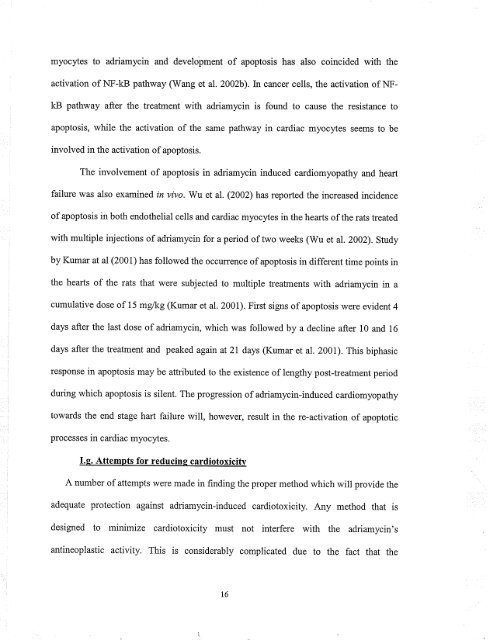il\VOLVEMENT OF RETII\OIC ACID II{ - MSpace at the University of ...
il\VOLVEMENT OF RETII\OIC ACID II{ - MSpace at the University of ...
il\VOLVEMENT OF RETII\OIC ACID II{ - MSpace at the University of ...
You also want an ePaper? Increase the reach of your titles
YUMPU automatically turns print PDFs into web optimized ePapers that Google loves.
myocytes to adriamycin and development <strong>of</strong> apoptosis has also coincided with <strong>the</strong><br />
activ<strong>at</strong>ion <strong>of</strong> NF-kB p<strong>at</strong>hway (Wang et a1.2002b). In cancer cells, <strong>the</strong> activ<strong>at</strong>ion <strong>of</strong> NFkB<br />
p<strong>at</strong>hway after <strong>the</strong> tre<strong>at</strong>ment with adriamycin is found to cause <strong>the</strong> resistance to<br />
apoptosis, while <strong>the</strong> activ<strong>at</strong>ion <strong>of</strong> <strong>the</strong> same p<strong>at</strong>hway in cardiac myocytes seems to be<br />
involved in <strong>the</strong> activ<strong>at</strong>ion <strong>of</strong> apoptosis.<br />
The involvement <strong>of</strong> apoptosis in adriamycin induced cardiomyop<strong>at</strong>hy and heart<br />
failure was also examined in vivo. 'Wu et al. (2002) has reported <strong>the</strong> increased incidence<br />
<strong>of</strong> apoptosis in both endo<strong>the</strong>lial cells and cardiac myocytes in <strong>the</strong> hearts <strong>of</strong> <strong>the</strong> r<strong>at</strong>s tre<strong>at</strong>ed<br />
with multiple injections <strong>of</strong> adriamycin for a period <strong>of</strong> two weeks (Wu et al. 2002). Study<br />
by Kumar <strong>at</strong> al (2001) has followed <strong>the</strong> occurrence <strong>of</strong> apoptosis in different time points in<br />
<strong>the</strong> hearts <strong>of</strong> <strong>the</strong> r<strong>at</strong>s th<strong>at</strong> were subjected to multiple tre<strong>at</strong>ments with adriamycin in a<br />
cumul<strong>at</strong>ive dose <strong>of</strong> 15 mg/kg (Kumar et al. 2001). First signs <strong>of</strong> apoptosis were evident 4<br />
days after <strong>the</strong> last dose <strong>of</strong> adriamycin, which was followed by a decline after 10 and 16<br />
days after <strong>the</strong> tre<strong>at</strong>ment and peaked again <strong>at</strong> 2I days (Kumar et al. 2001). This biphasic<br />
response in apoptosis may be <strong>at</strong>tributed to <strong>the</strong> existence <strong>of</strong> lengthy post-tre<strong>at</strong>ment period<br />
during which apoptosis is silent. The progression <strong>of</strong> adriamycin-induced cardiomyop<strong>at</strong>hy<br />
towards <strong>the</strong> end stage hart failure will, however, result in <strong>the</strong> re-activ<strong>at</strong>ion <strong>of</strong> apoptotic<br />
processes in cardiac myocytes.<br />
I.g. Attempts for reducine cardiotoxicÍty<br />
A number <strong>of</strong> <strong>at</strong>tempts were made in finding <strong>the</strong> proper method which will provide <strong>the</strong><br />
adequ<strong>at</strong>e protection against adriamycin-induced cardiotoxicity. Any method th<strong>at</strong> is<br />
designed to minimize cardiotoxicity must not interfere with <strong>the</strong> adriamycin's<br />
antineoplastic activity. This is considerably complic<strong>at</strong>ed due to <strong>the</strong> fact th<strong>at</strong> <strong>the</strong><br />
t6







![an unusual bacterial isolate from in partial fulf]lment for the ... - MSpace](https://img.yumpu.com/21942008/1/190x245/an-unusual-bacterial-isolate-from-in-partial-fulflment-for-the-mspace.jpg?quality=85)





![in partial fulfil]ment of the - MSpace - University of Manitoba](https://img.yumpu.com/21941988/1/190x245/in-partial-fulfilment-of-the-mspace-university-of-manitoba.jpg?quality=85)


